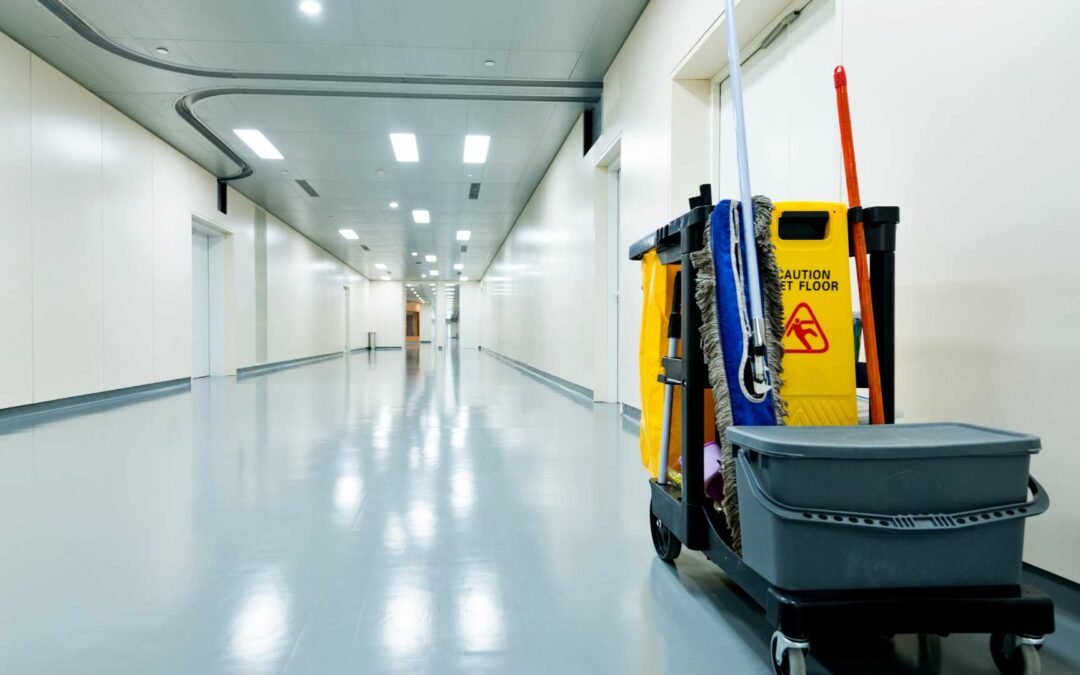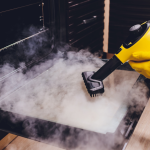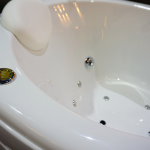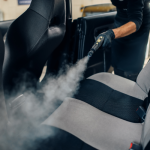In healthcare settings, the utmost priority is given to cleanliness and hygiene to safeguard patients’ well-being and the overall safety of healthcare facilities. Routine cleaning and disinfection of patient rooms, adhering to strict hospital guidelines, are crucial practices in these environments.
Healthcare facility cleaning services are critical for several reasons.
Firstly, maintaining cleanliness in patient areas is vital to reduce the risk of HAIs. Visibly soiled surfaces can harbor dangerous pathogens, making routine cleaning an integral part of infection prevention.
The cleaning process in healthcare settings must be meticulously executed, focusing on high-touch surfaces, equipment, and communal spaces. The use of personal protective equipment (PPE) by cleaning staff is crucial for their safety and to minimize cross-contamination.
Apart from infection control, healthcare cleaning also influences patient experience and safety. A clean environment positively affects patient outcomes, comfort, and satisfaction, often being associated with the quality of care received.
Healthcare facilities are under stringent regulatory scrutiny, and adherence to cleanliness standards is a legal requirement. In summary, healthcare facility cleaning is essential for infection prevention, patient safety, and regulatory compliance, forming a foundational aspect of healthcare quality and ensuring a safe, healing environment for patients.
Optimal Methods for Sanitizing and Disinfecting an Occupied Patient Room in Hospitals
When it comes to sanitizing and disinfecting a patient room that is currently in use within a hospital, there are key best practices to ensure the safety of both patients and healthcare workers.
Routine Cleaning
Initially, regular cleaning should be conducted with thorough attention, focusing on frequently touched surfaces such as door handles, light switches, bedside tables, and remote controls.
Use of Personal Protective Equipment
It’s also vital for cleaning personnel to follow strict infection control protocols, including wearing the necessary personal protective equipment (PPE), like gloves and gowns, to prevent the spread of pathogens.
Airborne Precautions
Additionally, given the importance of airborne precautions in healthcare environments, maintaining proper ventilation and air flow in the patient room is crucial to reduce the risk of airborne transmission of infectious agents.
Implementing these best practices ensures a clean and secure setting in the patient room, reducing the chance of healthcare-associated infections and promoting the health and safety of patients and staff.
Cleaning in Isolation Units
In hospital settings, cleaning isolation units is a critical step to prevent the spread of pathogens and maintain a safe healthcare environment. The process, often referred to as “terminal cleaning,” requires thorough cleaning and disinfection of all room surfaces, including frequently touched areas like door handles, light switches, and bed rails. Special attention should also be paid to floors. Cleaning staff must wear appropriate PPE to limit exposure to infectious materials.
Proper disinfectants, in line with hospital guidelines, should be used to effectively eradicate pathogens.
By adhering to these strict cleaning practices, healthcare facilities can significantly lower the risk of pathogen spread in isolation units, thereby protecting patients and healthcare workers.
Hospital Cleaning Techniques
Hospital cleaning procedures are carefully designed to maintain a hygienic environment conducive to patient safety and infection control.
In patient rooms and wards, routine cleaning encompasses thorough disinfection of commonly touched surfaces, including bedrails and countertops.
In more critical areas like operating rooms, rigorous cleaning protocols with specialized disinfectants and sterilization methods are employed to eliminate pathogens and uphold high cleanliness standards.
Immediate and safe cleaning of bodily fluid spills is crucial to avoid cross-contamination, while trash receptacles are emptied and cleaned regularly.
These procedures are consistently implemented to create a healthcare environment that minimizes healthcare-associated infection risks and supports the health and well-being of patients and staff.
Sanitizing All Surfaces
Cleaning and disinfecting both high- and low-touch surfaces is crucial in preventing infection spread in healthcare and public settings.
The process starts with cleaning staff wearing proper PPE, such as gloves. High-touch areas like door handles and switches require thorough cleaning to remove visible dirt, dust, or fluids, followed by the application of hospital-grade disinfectants.
The disinfectant should remain on the surface for the recommended duration to effectively neutralize pathogens.
Less frequently touched surfaces should also be regularly cleaned and disinfected, focusing on removal of dirt or dust.
Throughout this process, measures are taken to prevent cross-contamination, like changing cleaning cloths between different areas.
By meticulously following these cleaning protocols and using appropriate products, healthcare and public facilities can significantly reduce disease transmission risks, ensuring a safer environment for everyone.
Choosing the Right Cleaning Equipment: The Benefits of Steam Cleaners
In the vast array of cleaning equipment available today, it’s wise to carefully consider your purchases. Rather than overspending on unnecessary items, consider the investment in a steam cleaner, especially for hospital settings.
Advantages of Steam Cleaners
Steam cleaning technology stands out for its significant advantages in cleaning hospital environments. This method employs high-temperature steam for effectively cleaning and disinfecting surfaces, making it highly beneficial in healthcare settings where disease prevention and safety are critical.
In critical areas like operating rooms, which demand the utmost cleanliness, steam cleaning offers an in-depth, chemical-free solution for eradicating pathogens. The intense heat of the steam not only visibly cleans but also ensures surfaces are microbiologically safe, effectively killing bacteria and viruses.
Moreover, steam cleaning is an eco-friendly option, reducing reliance on harsh chemical cleaners that could harm the environment and staff. It also lessens the likelihood of chemical residue on frequently touched surfaces, fostering a safer healthcare environment for patients, staff, and visitors.
Overall, steam cleaning is an invaluable asset in upholding the strict hygiene standards required in hospitals, focusing on disease control and occupational safety.
The Steam Cleaning Process in Hospitals
Steam cleaning is highly effective for maintaining cleanliness and hygiene in various hospital areas.
Operating Room:
In the operating room, steam cleaning is vital for maintaining a sterile environment. The process starts with a detailed inspection to spot any visible contaminants. Then, steam cleaning equipment applies high-temperature steam to surfaces, effectively sterilizing them. This method is particularly effective for cleaning surgical equipment and stainless steel surfaces, crucial in operating rooms. The intense heat of the steam eliminates bacteria and viruses, playing a key role in preventing surgical site infections.
Patient’s Room:
In patient rooms, steam cleaning is invaluable for sanitizing high-touch surfaces like bedrails, tables, and door handles, eradicating pathogens and maintaining cleanliness. This reduces healthcare-associated infection risks and reassures patients and their families.
Waiting Areas:
Steam cleaning is also beneficial in waiting areas, frequented by many people. It’s used on upholstered furniture, carpets, and hard surfaces like chairs and tables, removing stains, dirt, and bacteria, thus ensuring a welcoming and safe space for patients and visitors.
Door Handles:
Regular steam cleaning of door handles in patient care areas is essential to mitigate the spread of germs and minimize cross-contamination among staff, patients, and visitors.
Effective steam cleaning in hospitals hinges on using appropriate equipment, adhering to protocols, and having trained personnel perform the procedures. Incorporating steam cleaning into routine cleaning practices allows healthcare facilities to achieve high cleanliness standards, lower infection risks, and provide a safer, more comfortable environment for everyone involved.
How is Cleaning Conducted in a Healthcare Setting?
In a healthcare setting, cleaning is a rigorously organized and implemented process, aimed at ensuring a safe, hygienic, and infection-free environment. It involves specialized staff trained to follow stringent protocols for removing contaminants, including harmful pathogens, to protect patients, staff, and visitors.
This process generally encompasses regular cleaning and sanitizing of frequently touched surfaces like door handles, bedrails, and medical equipment. In critical spaces such as patient rooms and operating theaters, advanced cleaning methods and hospital-grade disinfectants are used to guarantee a sterile environment.
Healthcare cleaning practices are grounded in infection control guidelines and regulatory standards, highlighting the essential role of cleanliness in safeguarding patient health and preventing healthcare-associated infections.
Through meticulous attention to detail and compliance with established protocols, healthcare cleaning is a crucial factor in fostering a secure and therapeutic atmosphere within medical facilities.




